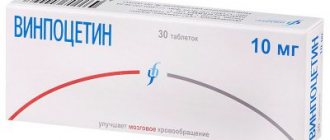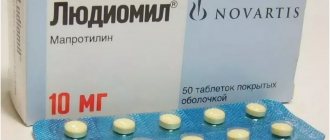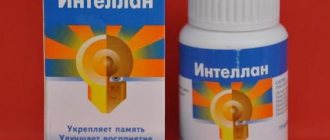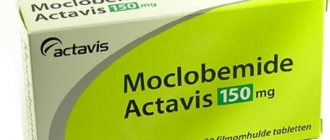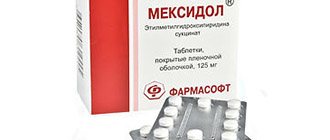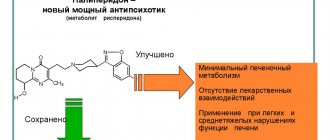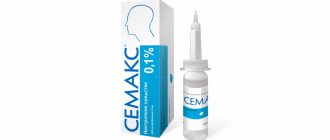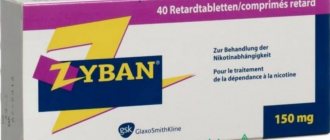Pharmacological properties of the drug Nicergoline
Nicergoline's chemical structure is an analogue of ergot alkaloids, containing, in addition to the ergoline core, a bromine-substituted nicotinic acid residue. By analogy with dihydrogenated derivatives of ergot alkaloids, nicergoline has an α-adrenergic blocking effect. In addition, it exhibits antispasmodic activity, especially in relation to cerebral and peripheral vessels. The drug increases blood flow, especially in patients with functional arteriopathy, improves the condition of patients with impaired brain function due to vascular insufficiency, is effective for disorders of the central and peripheral circulation, and has a beneficial effect on the condition of patients during the recovery period after cerebral ischemia. Nicergoline improves hemodynamics and metabolism both in the brain and in peripheral tissues. The use of nicergoline in patients with neurosurgical pathology has a positive effect on the functional tone of the systems of visceral-autonomic regulation of cerebral blood flow and bioelectrical activity of the brain, affecting mainly the limbic structures of the brain and the hypothalamus. The drug has an antiplatelet effect and has a positive hemorheological effect; improves neuropsychic status in people with senile dementia. After oral administration, nicergoline is rapidly and almost completely absorbed. The rate and volume of absorption of nicergoline does not depend on food intake. More than 90% of nicergoline binds to blood plasma proteins, showing a more pronounced affinity for acidic α-glycoprotein than for albumin. Nicergoline is metabolized in the liver to form two main metabolites. Excreted mainly in urine; a small amount of nicergoline and/or its metabolites is excreted in the bile.
Nicergoline (sermion) is a hydrated semi-synthetic derivative of ergoline (contains an ergoline core and a bromine-substituted nicotinic acid residue). The pharmacotherapeutic effectiveness of this drug is determined by two main properties: an adrenergic blocking effect, leading to improved blood flow, and a direct effect on the cerebral neurotransmitter systems - noradrenergic, dopaminergic and acetylcholinergic. Nicergoline is used to treat cerebrovascular insufficiency, cognitive impairment in the elderly, including various forms of dementia, as well as a number of other disorders, mainly of a vascular nature [1-4, 9, 16, 18]. The drug was developed in the late 60s of the 20th century, and it began to be used in clinical practice in the 70s, first in Italy and then in other countries [16, 18]. Currently, nicergoline is registered in more than 50 countries (Europe, Asia, Latin America) [18].
In clinical terms, nicergoline was initially considered as a vascular drug that antagonizes α1-adrenergic receptors, and its therapeutic efficacy was associated with vasodilation, decreased vascular resistance, and increased arterial blood flow [1, 8, 16, 18]. Therefore, it was used mainly to treat dementia due to cerebrovascular insufficiency. However, further studies have shown that nicergoline has a much wider spectrum of action - at the molecular and cellular levels, acting not only on blood vessels, but also blood cells (platelets) and neurons [18]. Currently, the drug is used for dementia of various origins (Alzheimer's disease, vascular dementia), cerebrovascular disorders (including stroke, transient ischemic attacks, post-stroke disorders, migraine), peripheral vascular disorders (obliterating atherosclerosis of the vessels of the lower extremities), imbalances of vestibular origin, with glaucoma, Parkinson's disease, as well as benign prostatic hyperplasia [18].
When taken orally, the drug has linear pharmacokinetics, which is practically independent of age; it is quickly and almost completely absorbed in the gastrointestinal tract [1, 18]. Food intake does not have a significant effect on the absorption of nicergoline. Unlike another ergot derivative, hydrergine, nicergoline is excreted primarily in the urine (80%) in the form of metabolites, and only about 20% in feces [1, 18]. In healthy volunteers, it was shown that after taking a tablet drug, its maximum concentration in the blood serum is achieved within 3 hours, and the half-life is about 15 hours [18]. Nicergoline is usually prescribed at a dose of 30 mg 2 times a day, the duration of therapy ranges from 2 to 12 months or more [16, 18]. In Asian countries, nicergoline is usually used in smaller doses (however, like other drugs with similar effects) [18].
Mechanism of action
Data from numerous experimental studies indicate a wide spectrum of action of nicergoline, which explains its effectiveness in diseases of various etiologies and pathogenesis. It improves cognitive functions regardless of the etiology of the disease [6].
When administered nicergoline, there is an increase in regional cerebral blood flow, improvement in glucose utilization processes, and activation of protein synthesis [1, 2, 4, 16, 18]. The nicotinic acid residue contained in the nicergoline molecule has a direct myotropic antispasmodic effect on the muscular lining of blood vessels, especially the vessels of the brain and limbs. The experiment showed that nicergoline reduces vascular resistance of the carotid and vertebrobasilar systems and improves cerebral blood flow and metabolism [18]. A positive effect of a course of nicergoline on lipid metabolism was noted [3].
The improvement in metabolic processes in the brain parenchyma resulting from the action of nicergoline was confirmed by spectroscopy data [18]. At the same time, the literature emphasizes that this drug has a positive effect on the basic, fundamental molecular processes underlying the onset and progression of dementia [16, 18].
One of the mechanisms of action of nicergoline is a disaggregating effect caused by a decrease in platelet aggregation and an increase in the plasticity of erythrocytes, which, in combination with the effect on cerebral vessels, leads to an improvement in regional cerebral blood flow in ischemic tissue [1, 18]. Taking into account the positive effect on platelet and erythrocyte aggregation, nicergoline is considered as a drug that reduces the risk of developing thromboembolic cerebral complications [18].
A study of the state of microcirculation of the bulbar conjunctiva showed that under the influence of a course of treatment with nicergoline, there was an acceleration of blood flow and a decrease in the severity of sludge syndrome [3]. This effect was more often recorded in arterioles and capillaries and less clearly in venules. In ⅓ of the examined patients there was an expansion of conjugate arterioles, reaching 10% of the initial diameter, and in 15-30% of patients (depending on age) there was an increase in the number of functioning capillaries per unit area of the bulbar conjunctiva [3]. In 1/3 of elderly patients in this study, disappearance or reduction of perivascular edema was observed.
Recently, its influence on the processes of neuroplasticity [8, 16, 18] and the mechanisms of neuroprotection [2, 7] has been shown. It is important to note that the neuroprotective properties of nicergoline are not associated with its direct effect on noradrenergic α1 receptors and serotonergic 5-HT1A receptors, but are global in nature. This is to a large extent due to the ability of nicergoline, acting through endogenous neurotrophic factors, to provide the trophic functions of cholinergic neurons [16], which leads to their survival under pathological conditions, including aging [10]. Experimental data indicate an increase in the concentration of nerve growth factor in the frontal regions of the brain in old animals (rats) that received nicergoline [18]. These mechanisms explain the ability of sermion (nicergoline) to slow down the progression of cognitive disorders in vascular pathology of the brain and Alzheimer's disease [6]. Current evidence suggests that nicergoline can “protect” neurons from the toxic effects of beta-amyloid, thereby slowing the progression of Alzheimer’s disease [7].
Experimental studies have shown the neuroprotective effect of nicergoline during hypoxia, even under conditions of hypercapnia, when cerebral vessels are in a state of dilation, indicating its direct effect on the brain parenchyma [8]. Intraventricular administration of nicergoline has been shown to affect both blood pressure and heart rate in anesthetized dogs and also inhibit T- and L-type neuronal calcium channels [8]. The neuroprotective properties of this drug are manifested in the protection of neurons from death under conditions of oxidative stress [16, 18]. When prescribing nicergoline, the processes of lipid peroxidation are reduced and the excessive formation of free radicals is reduced. There is evidence [16] that the antioxidant effect of nicergoline is comparable to the effect of the classical antioxidant tocopherol (vitamin E). Nicergoline also acts on the process of apoptosis [2, 16].
Nicergoline increases the synthesis of acetylcholine by activating choline acetyltransferase, increases the release of acetylcholine from presynaptic terminals, reduces the breakdown of acetylcholine by inhibiting acetylcholinesterase, and also acts on postsynaptic M-cholinergic receptors in the central nervous system [18]. It increases the level of acetylcholine in the cortex and striatum of old animals (rats), while no changes in the level are observed in young animals [15, 18]. In addition, nicergoline restores the age-related decrease in acetylcholine levels in the hippocampus [15, 16, 18]. Inhibition of acetylcholinesterase when using nicergoline is quite comparable to the similar effect of physostigmine, although inferior to the effect of tacrine [16]. A decrease in acetylcholinesterase activity in the brain after intravenous and intraperitoneal administration of nicergoline was confirmed experimentally [18]. The identified changes in the acetylcholinergic system in experimental animals were accompanied by better performance in tests for mnestic functions [18]. The additional positive effect of nicergoline is due to its influence on other neurotransmitter systems (adrenergic, serotonergic) [15, 16].
Animals treated with nicergoline showed an improvement in the performance of tasks associated with mnestic activity [15]. Moreover, the degree of improvement increases with increasing duration of therapy [15].
The nootropic and antiamnestic activity of nicergoline was confirmed in models of experimental cerebral ischemia and using toxic agents that selectively disrupt mnestic functions [18].
Clinical researches
Nicergoline has been successfully used to treat dementia of various origins [1, 9, 11, 16, 18]. The positive effect of the drug in the form of a decrease in the severity of cognitive and behavioral disorders is noted, according to some data, in almost 89% of patients (when a placebo is prescribed, an improvement, usually transient in nature, is observed in 26-50% of cases) [18].
The first studies examining the effectiveness of nicergoline in dementia used the Sandoz Clinical Geriatric Scale (SCAG) and the Clinical Global Impression (CGI) scale for assessment, followed by the Mini-Mental State Examination (MMSE) and the Alzheimer's Disease Assessment Scale (ADAS). ) [18].
The difference in clinical effect between the group of patients receiving nicergoline and those receiving placebo ranges from 5 to 30%, depending on the duration of the course of therapy and the characteristics of the patients included in the study [9].
Data from clinical studies [13, 14, 18] indicate that treatment with nicergoline improves the condition of patients with both Alzheimer's disease and vascular (multi-infarct) dementia during treatment with nicergoline. In addition, the drug is also effective for dementia of the mixed (Alzheimer’s and vascular) type [11, 18]. In addition to the immediate positive effect on cognitive functions, a fairly rapid decrease in the severity of apathy was noted [11].
Thus, significant improvement was observed in younger patients and in patients with less severe cognitive impairment [18]. In addition, nicergoline therapy is thought to result in marked improvement in vascular dementia than in Alzheimer's disease or other types of dementia [18]. However, this may be due to differences in the designs of the studies conducted to date. It is interesting to note that the effect of therapy on the latency dynamics of the P300 wave of the cognitive evoked potential in vascular (multi-infarct) dementia and Alzheimer's disease do not differ in nature from each other [18].
In patients with discirculatory encephalopathy, after a course of therapy with nicergoline, an improvement in the subjective state is observed in the form of a decrease or cessation of headaches, dizziness, noise in the head, and fatigue [3]. According to neuropsychological testing, a significant decrease in the time required to complete tasks according to Schulte tables was revealed [3]. It is important to note that the positive effect of the drug persisted for a long time after the end of the course of therapy.
The effect of nicergoline is dose-dependent, which is confirmed by the results of electrophysiological research methods [16]. During therapy with nicergoline in patients with dementia, α- and β-activity on the EEG increases, in combination with a decrease in θ- and Δ-waves, which, in turn, correlates with improved attention and memory [1, 13, 14].
Improvement in the cognitive sphere occurs in parallel with an increase in blood flow velocity in the middle and anterior cerebral arteries, as well as in the right parietal region [18].
It should be noted that nicergoline is considered an effective drug for the treatment of various types of vascular dementia, including multi-infarct dementia [5, 12]. As the duration of treatment increases from 6 months to 12 months, the effectiveness of therapy also increases [9]. In addition, during treatment with nicergoline, the progression of cognitive disorders slows down [16], and the differences between the group of patients receiving nicergoline and those receiving placebo increase with increasing study duration [11]. In this regard, the results of assessing the effectiveness of nicergoline during long-term (24 months) therapy in patients with leukoaraiosis against the background of arterial hypertension, but without dementia, are very indicative - in the group of patients receiving the drug, there was a slowdown in the progression of cognitive disorders, and in some neuropsychological parameters (memory , attention) - their improvement [6].
The effectiveness of the drug in moderate and severe Alzheimer's disease was confirmed in a multicenter, double-blind, placebo-controlled, randomized study conducted in 33 European centers (Italy, Sweden, Great Britain, Belgium and Germany) [17].
Another indication for prescribing this drug is post-stroke disorders [3, 18]. In addition to improvement in the cognitive sphere, which is confirmed by data from a study of the P300 wave of cognitive evoked potential, patients also noted a decrease in the severity of post-stroke motor defect [18]. The most significant result was observed in patients with a lower degree of hemiparesis. Thus, the use of nicergoline in patients who have suffered a stroke improves the course of the rehabilitation period, accelerates the recovery of both cognitive and motor functions, ultimately positively affecting the quality of life of patients.
Studies on the effectiveness of nicergoline in Parkinson's disease are few, however, even here a decrease in the severity of cognitive, emotional, personal and behavioral disorders was noted during therapy with this drug [18].
The positive effect of nicergoline was also noted for migraine. It consists in reducing the severity of headaches and stopping attacks [3].
Indications for the use of nicergoline are also imbalances caused by vestibular dysfunction. Data from experimental studies indicate the ability of this drug to improve compensation of vestibular disorders due to its dopaminergic effect [18]. In patients with balance disorders and dizziness as the leading symptom, positive dynamics in the condition, accompanied by an improvement in the quality of life, are noted in 44-78% of cases [18]. The results of the clinical assessment were confirmed by posturography data. In patients with discirculatory encephalopathy after a course of therapy with nicergoline, a decrease in dizziness, a decrease or disappearance of staggering when performing the Romberg test were noted [3].
Safety and Tolerability
The drug is well tolerated [6, 11, 16, 17]. In particular, the nature, frequency of occurrence and severity of adverse reactions in patients receiving nicergoline are quite comparable to the effect of placebo [6, 16, 18]. Moreover, even if side effects occur, they tend to decrease as therapy continues [1]. Among the adverse reactions that are quite typical for the entire class of ergot derivatives, complaints of dry mouth, constipation, and diarrhea should be noted. When taking the drug orally, systolic and diastolic blood pressure do not change significantly, and only sometimes decrease slightly (without a statistically significant difference with patients receiving placebo) [18]. With a single intravenous administration of nicergoline, a decrease in blood pressure was detected already at the 5th minute, which returned to the initial level by the end of the first hour [3]. In this regard, certain caution is emphasized when administering nicergoline intravenously to patients in older age groups [3]. Patients with initially high blood pressure may experience a bursting headache after administration of the drug [3].
As found by B. Winblad et al. [17], in the group of patients receiving nicergoline, side effects requiring discontinuation of treatment were observed in 8.5% of cases, in the group receiving placebo - in 8.3% of cases. During therapy with nicergoline, there are no statistically significant changes in vital functions and laboratory parameters, with the exception of a slight increase in the level of uric acid in the blood serum in some cases, which is not accompanied by any clinical symptoms [16, 17]. However, this must be taken into account in patients with a history of gout.
Thus, nicergoline has been used in clinical practice for almost 40 years. During this time, considerable experience has been accumulated in the use of this drug in conditions of various pathogenesis. And if initially nicergoline was considered as an exclusively “vascular” drug, leading to an improvement in cerebral blood flow due to an antagonistic effect on α1-adrenergic receptors, then a significantly wider spectrum of its action was later demonstrated. Nicergoline has a positive effect on the cholinergic and catecholaminergic neurotransmitter systems, inhibits platelet aggregation, improves cerebral metabolism, increasing the utilization of oxygen and glucose, and has anti-apoptotic, antioxidant and neurotrophic activity. All this allows us to consider nicergoline not only as a symptomatic agent, but also as a drug with a neuroprotective effect. The combination of effectiveness with good tolerability makes the drug Sermion (nicergoline) very popular, especially in neurogeriatric practice.
